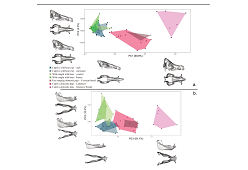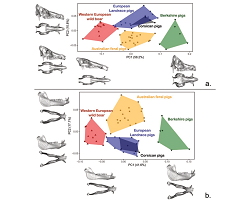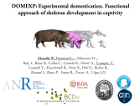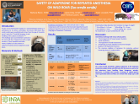Articles
Dimitri Neaux, Hugo Harbers, Barbara Blanc, Katia Ortiz, Yann Locatelli, Anthony Herrel, Vincent Debat & Thomas Cucchi, 2022. The effect of captivity on craniomandibular and calcaneal ontogenetic trajectories in wild boar. J Exp Zool B Mol Dev Evol. 2022;1–11. DOI: 10.1002/jez.b.23130
Deciphering the plastic (i.e., nonheritable) changes induced by human control over
wild animals in the archeological record is challenging. Previous studies detected
morphological markers associated with captivity in the cranium, mandible, and
calcaneus of adult wild boar (Sus scrofa) but the developmental trajectories leading
up to these changes during ontogeny remain unknown. To assess the impact of
growth in a captive environment on morphological structures during postnatal
ontogeny, we used an experimental approach focusing on the same three structures
and taxon. We investigated the form and size differences of captive‐reared and wild‐
caught wild boar during growth using three‐dimensional landmark‐based geometric
morphometrics. Our results provide evidence of an influence of captivity on the
morphology of craniomandibular structures, as wild specimens are smaller than
captive individuals at similar ages. The food resources inherent to anthropogenic
environments may explain some of the observed differences between captive‐
reared and wild specimens. The calcaneus presents a different contrasted pattern of
plasticity as captive and wild individuals differ in terms of form but not in terms of
size. The physically more constrained nature of the calcaneus and the direct
influence of mobility reduction on this bone may explain these discrepancies. These
results provide new methodological perspectives for bioarchaeological approaches
as they imply that the plastic mark of captivity can be observed in juvenile specimens
in the same way it has been previously described in adults.
Dimitri Neaux, Barbara Blanc, Katia Ortiz, Yann Locatelli, Renate Schafberg, Anthony Herrel, Vincent Debat & Thomas Cucchi, 2021. Constraints associated with captivity alter craniomandibular integration in wild boar. Journal of Anatomy. DOI: 10.1111/joa.13425
The domestication process is associated with substantial phenotypic changes through
time. However, although morphological integration between biological structures
is purported to have a major influence on the evolution of new morphologies, little
attention has been paid to the influence of domestication on the magnitude of integration.
Here, we assessed the influence of constraints associated with captivity,
considered as one of the crucial first steps in the domestication process, on the integration
of cranial and mandibular structures. We investigated the craniomandibular
integration in Western European Sus scrofa using three-dimensional
(3D) landmark-based
geometric morphometrics. Our results suggest that captivity is associated with
a lower level of integration between the cranium and the mandible. Plastic responses
to captivity can thus affect the magnitude of integration of key functional structures.
These findings underline the critical need to develop integration studies in the context
of animal domestication to better understand the processes accountable for the
set-up
of domestic phenotypes through time.
Hugo Harbers, Clement Zanolli, Marine Cazenave, Jean‑Christophe Theil, Katia Ortiz, Barbara Blanc, Yann Locatelli, Renate Schafberg, Francois Lecompte, Isabelle Baly, Flavie Laurens, Cécile Callou, Anthony Herrel, Laurent Puymerail & Thomas Cucchi, 2020. Investigating the impact of captivity and domestication on limb bone cortical morphology: an experimental approach using a wild boar model. Scientific Reports
(https://doi.org/10.1038/s41598-020-75496-6).
The lack of bone morphological markers associated with the human control of wild animals has
prevented the documentation of incipient animal domestication in archaeology. Here, we assess
whether direct environmental changes (i.e. mobility reduction) could immediately affect ontogenetic
changes in long bone structure, providing a skeletal marker of early domestication. We relied on a
wild boar experimental model, analysing 24 wild-born specimens raised in captivity from 6 months
to 2 years old. The shaft cortical thickness of their humerus was measured using a 3D morphometric
mapping approach and compared with 23 free-ranging wild boars and 22 pigs from different breeds,
taking into account sex, mass and muscle force differences. In wild boars we found that captivity
induced an increase in cortical bone volume and muscle force, and a topographic change of cortical
thickness associated with muscular expression along a phenotypic trajectory that differed from
the divergence induced by selective breeding. These results provide an experimental proof of
concept that changes in locomotor behaviour and selective breeding might be inferred from long
bones morphology in the fossil and archaeological record. These trends need to be explored in the
archaeological record and further studies are required to explore the developmental changes behind
these plastic responses.
Hugo Harbers, Dimitri Neaux, Katia Ortiz, Barbara Blanc, Flavie Laurens, Isabelle Baly, Cécile Callou, Renate Schafberg, Ashleigh Haruda, François Lecompte, François Casabianca, Jacqueline Studer, Sabrina Renaud, Raphael Cornette, Yann Locatelli, Jean-Denis Vigne, Anthony Herrel & Thomas Cucchi, 2020. The mark of captivity: plastic responses in the ankle bone of a wild ungulate
(Sus scrofa). R. Soc. open sci. 7: 192039.
(http://dx.doi.org/10.1098/rsos.192039).
Deciphering the plastic (non-heritable) changes induced by human control over wild animals in the archaeological record is
challenging. We hypothesized that changes in locomotor behaviour in a wild ungulate due to mobility control could be quantified in the bone anatomy. To test this, we experimented with the effect of mobility reduction on the skeleton of wild boar (Sus scrofa), using the calcaneus shape as a possible phenotypic marker. We first assessed differences in shape variation and covariation in captive-reared and wild-caught wild boars, taking into account differences in sex, body mass, available space for movement and muscle force. This plastic signal was then contrasted with the phenotypic changes induced by selective breeding in domestic pigs. We found that mobility reduction induces a plastic response beyond the shape variation of wild boars in their natural habitat, associated with a reduction in the range of locomotor behaviours and muscle loads. This plastic signal of captivity in the calcaneus shape differs from the main changes induced by selective breeding for larger muscle and earlier development that impacted the pigs’ calcaneus shape in a much greater extent than the mobility reduction during the domestication process of their wild ancestors.
Dimitri Neaux, Barbara Blanc, Katia Ortiz, Yann Locatelli, Flavie Laurens, Isabelle Baly, Cécile Callou, François Lecompte, Raphaël Cornette, Gabriele Sansalone, Ashleigh Haruda, Renate Schafberg, Jean‑Denis Vigne, Vincent Debat, Anthony Herrel & Thomas Cucchi, 2020. How Changes in Functional Demands Associated with Captivity Affect the Skull Shape of a Wild Boar (Sus scrofa). Evolutionary Biology.
(https://doi.org/10.1007/s11692-020-09521-x).
The process of animal domestication is a key evolutionary transition in human history, within which the control of wild
populations is considered a crucial first step. Yet, phenotypic changes associated with animal captivity remain challenging
to document. Here, we investigated the craniofacial changes in wild boar (Sus scrofa) associated with a lifetime of growth in
captivity under conditions of controlled mobility and diet. Using three-dimensional landmark-based geometric morphometrics,
we assessed cranial and mandibular size and shape differences between captive and wild-caught wild boar, their link with
masticatory forces, and how these plastic changes relate to traits selected in domestic pigs. We observed shape divergence
associated with greater masticatory forces in captive wild boar (e.g., wider zygomatic arches, more upright mandibular rami,
and reduced gonial angle) corroborating the fundamental role of biomechanical loading and constructional constraints in the
skull shape changes associated with captivity. Despite their resemblance with domestic traits, these localised plastic changes
follow a different phenotypic trajectory, suggesting that they did not contribute to the setup of the craniofacial morphology
of current domestic breeds. A parallel increase of masticatory force in captive wild boars and domestic pigs may explain
this phenotypic convergence but needs to be further explored.
Dimitri Neaux, Gabriele Sansalone, François Lecompte, Camille Noûs, Ashleigh Haruda, Renate Schafberg & Thomas Cucchi, 2020. Examining the effect of feralization on craniomandibular morphology in pigs, Sus scrofa (Artiodactyla: Suidae). Biological Journal of the Linnean Society, 2020, XX, 1–10.
Feralization is the process by which domestic animals return to the wild and produce self-sustaining populations.
It is often considered as a model in understanding the permanence of morphological changes associated with
domestication; however, it is still unclear how much the release of anthropogenic selective pressures affects domestic
traits. Here, we assessed the influence of feralization on the domestic morphological traits acquired through selective
breeding using craniomandibular differences in shape and size between populations of feral pigs, wild boar and
domestic pigs, using landmark-based geometric morphometrics. Our results suggest that numerous cranial and
mandibular traits associated with domestication still exist in feral specimens, corroborating that domesticationinduced
changes in the shape of morphological elements are broadly maintained in feral populations. This is not the
case for size variations, however, as the cranium is significantly smaller in feral pigs than in domesticated breeds,
which could be due to the selective pressures associated with founding events. Our exploratory study, therefore,
underlines the complexity of feral population history, the intricate influence of variations in genetic diversity, and
novel selection pressures in the morphology of these groups. Future studies will need to expand the sample to take
into account the diversity of morphotypes.
Oral communications
Laurens F., Baly I., Cucchi T., 2015. DOMEXP research project : presentation of its information system. 2èmes Journées de restitution BCDiv, Paris, France.
Documenting the earliest step of animal domestication still remains a huge challenge for zooarchaeologists. Not only because the process is elusive but also because the available morphological markers document an ongoing but not an emerging process. Indeed, according to the experiments, the morphological changes observed in domestic mammals are the pleiotropic results of strong behavioral selection. Captivity, on the other hand, considered by most as a catalyzer of the domestication process for the majority of domesticate mammals, has driven biomechanical and physiological changes in the animals’ environment which should have induced morphological changes through phenotypic plasticity, without any genetic modification. The first aim of DOMEXP is to capture this plastic signal in animal bones, and use it as a new bio-indicator of the early steps of animal domestication. The longer term objective of DOMEXP is to understand how these plastic responses have then driven the morphological changes during domestication.
The first stage of the DOMEXP project experiment the effect of captivity on the development of the musculoskeleton system on wild boar with a longitudinal study of individuals raised from 6 to 24 months in different contexts of mobility reduction. The development of their musculoskeleton system will be recorded using in vivo CT scan and MRI and analyzed with the latest 3D imagery techniques.
Cucchi T., Puymerail L., Adriaensen H., Baly, I., Blanc B., Callou C., Cornette R., Herrel A., Lecompte, F., Locatelli Y., Macchiarelli R., Ortiz K., Pellé E., Rabier R., Renaud S., Roux P. Simon R., Tresset A., Vigne J.D., 2014. EXPERIMENTAL DOMESTICATION Morpho Functional approach of skeleton development in captivity. ICAZ, 12th International Conference of Archeozoology, San Rafael, Argentina.
Most of morphological markers used in zooarchaeology to decipher the domestication signal in animal bones are considered to be tied to selection for less aggressive behaviour after experiments on carnivores using very drastic selective pressures. However, it is unlikely that such processes already acted at the beginning of the domestication process to build an observable phenotypic divergence. As such, these markers can hardly represent suitable templates for the investigation of domestication in other non carnivorous mammals at the early step of the domestication process.
Plastic, non heritable phenotypic modifications due to changes in lifestyle conditions have played a major role in these early steps of domestication but “environmental” or “plastic” morphological responses to conditions experienced by animals under human control have received very little attention despite their potential to generate fast responses in the context of the domestication process.
The DOMEXP project presented here aims at investigating the plastic responses of the internal and external structure of the skeleton during the growth of an ungulate model, the wild boar (Sus scrofa) in an experimental captive environment in order to generate new bio-indicators of the domestication processes applicable to the archaeological record.
Cucchi T., Puymerail L., Adriaensen H., Baly, I., Blanc B., Callou C., Cornette R., Herrel A., Lecompte, F., Locatelli Y., Macchiarelli R., Ortiz K., Pellé E., Rabier R., Renaud S., Roux P. Simon R., Tresset A., Vigne J.D., 2014. DOMEXP : Experimental domestication. Functional approach of skeleton development in captivity. Symposium National de Morphométrie et d'Evolution des Formes, Dijon, France.
Le projet DOMEXP a pour objectif d’identifier les conséquences biomécaniques de la captivité sur les structures internes et externes du squelette du sanglier (Sus scrofa) ; dont l’origine du processus de domestication échappe encore aux archéozoologues. Ce projet expérimental vise à obtenir de nouveaux bio-indicateurs de la captivité, catalyseur de la domestication au sens biologique. De tels marqueurs, reposant sur les réponses plastiques des structures osseuses, sont potentiellement mieux adaptés au traçage des premières étapes de l’histoire de la domestication à partir des vestiges ostéoarchéologiques que les critères classiques issus de sélections vraisemblablement tardives. La ferme expérimentale de sangliers située sur la réserve de la Haute Touche (MNHN), étudiera dans quelle mesure différentes contraintes fonctionnelles sur la locomotion (libre parcours, enclos et stabulation) pourraient trouver une expression phénotypique qualifiable et quantifiable dans le registre archéozoologique. Il mobilisera pour ce faire les dernières avancées en matière d’approches morpho-fonctionnelle tridimensionnelles pour accéder à la signature de la plasticité liée à la locomotion dans la morphologie osseuse, ce à l’aide d’observation longitudinales in vivo par utilisation d’imageries médicales bi-modales non invasive (INRA de Tours). Nous présenterons dans le cadre de ce symposium les premiers résultats issus des approches endostructurelles.
Posters
Blanc B., Ortiz K., Locatelli Y., Cucchi T., 2016. Safety of azaperone for repeated anesthesia on wild boar (Sus scrofa scrofa). 2016 Joint AAZV/EAZWV/IZW Conference, Atlanta, USA.
As part of an experimental study of a zooarcheological project, 24 wild boars (Sus scrofa scrofa)
had to be anesthetized every 3 months from the age of 6 months up to 2 years for CT and MRI
imaging. The challenge was to anesthetize 6 animals in the same half day of experiment with a
rapid recovery. A safe handling of this species could be delicate. 1,3,4 We took the opportunity
of these repeated anesthetic events to document an azaperone-based protocol adapted to wild
boars. Each animal was restrained in an individual crate and received an azaperone injection (2
mg/kg, IM), prior to a 2 hours transfer time. 3 Pigs were then anesthetized with a standard
combination of medetomidine (60 μg/kg, IM) and ketamine (6 mg/kg, IM), followed by 1 %
isoflurane maintenance by endotracheal tube. 2,3 This protocol was insufficient when animals
exceeded 30 kg. Adjusted doses of azaperone were added for anesthesia induction (1 to 2 mg/kg,
IM, depending on time after premedication). This anesthesia depth permitted IV catheter
placement. Intubation sometimes required an additional dose of ketamine (1 mg/kg, IV).
Anesthesia was closely monitored particularly body temperature (hypothermia and malignant
hyperthermia prevention 4 ). Animals were reversed in the crate with atipamezole (300 μg/kg,
IM). This azaperone-based protocol provided safety for the boars as well as for the veterinary
team handling these dangerous animals. Moreover, it allowed us to avoid increasing the
medetomidine dosage and its potential adverse effects on animals that will reach up to 100 kg.













